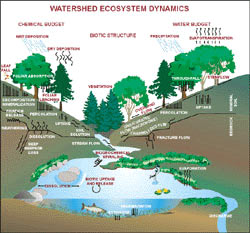Summary
In this Watershed Ecology module, you have been introduced to the most basic features of an exceedingly complex type of natural system -- the physical template, the biological setting, the traits and behavior of natural systems, and watershed structure and function. In closing, examine the graphic of watershed dynamics at left (you may click to enlarge it to full screen size after reading this) and think particularly about all the interactions occurring even in this simplified example. It is truly important for watershed managers to appreciate the natural processes at work, and how they are beneficial to our communities as well as our ecosystems. Even more, it is crucial to recognize how change affects watersheds and can jeopardize these benefits in very costly ways, when a normal change becomes great enough to be a change of concern. For more on this topic, please visit the Watershed Academy Web module on Watershed Change.
Self-Test for Watershed Ecology Module
Acknowledgments
Appreciation is expressed for the use of the following figures from the following sources:
Slides 2, 3d, 7b, 7c, 10c, 12, 15b, 16a, 18b, 18c, 18d, 19a, 19b, 19c, 20a:
from Federal Interagency Stream Restoration Working Group, 1998. Stream Corridor Restoration: Principles, Processes and Practices. U.S. Government Printing Office, Washington, DC.
Slide 8: from Noss, R. 1990. Indicators for monitoring biodiversity: a hierarchical approach. Cons. Biol. 4(4): 355-364.
Slide 21: from Johnson and Van Hook, 1989. Analysis of biogeochemical cycling processes in Walker Branch Watershed.
References Cited
Federal Interagency Stream Restoration Working Group, 1998. Stream Corridor Restoration: Principles, Processes and Practices. U.S. Government Printing Office, Washington, DC.Hutchinson, G.E. 1957. A treatise on limnology. v. 1. Geography, physics, and chemistry. Wiley, New York.
Johnson and Van Hook, 1989. Analysis of biogeochemical cycling processes in Walker Branch Watershed. Springer-Verlag, New York.
Montgomery, D.R. and J.M. Buffington. 1993. Channel classification, prediction of channel response and assessment of channel condition. Report TFW-SH10-93-002, U of Washington, Seattle.
Naiman, R.J. (ed.) 1992. Watershed Management: Balancing Sustainability and Environmental Change. Springer-Verlag.
Naiman, R.J. and R. Bilby (eds.) 1998. River Ecology and Management: Lessons from the Pacific Northwest Coastal Ecoregion. Springer-Verlag.
Noss, R. 1990. Indicators for monitoring biodiversity: a hierarchical approach. Cons. Biol. 4(4): 355-364.
Rosgen, D. L. 1994. A classification of natural rivers. In: Catena 22(1994): 169-199.
Rosgen, D.L. 1996. Applied River Morphology. Wildland Hydrology, Pagosa Springs, CO.
Society of American Foresters. 1980. Forest cover types of the Conterminous United States. Society of American Foresters, Washington, DC.
Vannote, R.L., G.W. Minshall, K.W. Cummins, J.R. Sedell, and C.E. Cushing. 1980. The river continuum concept. Canadian Journal of Fisheries and Aquatic Sciences 37:130-137.
Ward, J.V. 1989. The four-dimensional nature of lotic ecosystems. Journal of the North American Benthological Society 8(1):2-8.
![[logo] US EPA](https://www.epa.gov/epafiles/images/logo_epaseal.gif)
